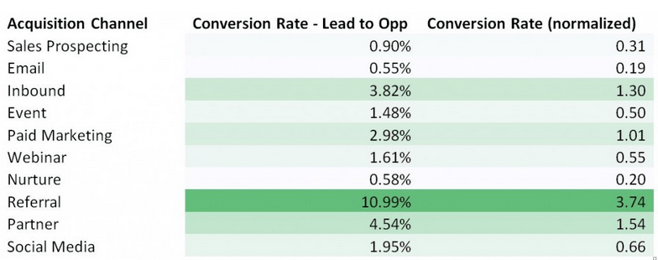Almost everything in inbound marketing can be measured, so why focus on conversion rates? Cost per conversion seems more useful when identifying lead generation channels that deliver ROI, and cost per acquisition is much better for determining the overall cost-effectiveness of a particular strategy.
Conversion rates are useful because, when measured against a benchmark, they can be used to identify and amend any underperforming channels. The abundance of data across both industries and channels makes it possible to quickly compare your conversion rates against those of competitors to see how your strategies are faring.
And while cost per conversion and lead quality are important guiding factors when it comes to channel selection, conversion rates should also be taken into account when you consider where to focus your resources. Together with the aforementioned variables, these readily available metrics help you get a clearer picture of how each of your channels contributes to the overall performance of your sales funnel.
Which conversion rate?
Of course, ‘conversion rate’ can refer to several different metrics, as it is a generic term for the rate at which customers perform the actions that move them from one stage in the sales funnel to the next:
- Visitor to unqualified lead
- Unqualified lead to marketing-qualified lead
- Marketing-qualified lead to sales-qualified lead
- Sales-qualified lead to customer (win rate)
In the activity of lead generation, however, this usually refers to the first transition – that from visitor to unqualified lead. In this stage, a visitor submits their contact details in exchange for access to content. With this transaction, a visitor becomes a lead who can then be sent automated emails designed to guide them down the sales funnel.
What are those benchmarks?
Conversion rate averages vary across industries and across channels. To get a more or less accurate idea of how one of your channels is performing, you need to compare it to the conversion rate for the same channel as used by other businesses in the same industry. If for example, you were in marketing, you would need to compare your conversion rate for social media to that of the likes of Marketo, shown here:

According to this table, inbound is twice as effective as social media at generating leads, and social media is twice as effective as sales prospecting - no surprise there. What is surprising is how many times more effective referrals (word-of-mouth) are than anything else.
What can you learn from this? Deliver great customer service, and your customers will be your greatest means of promotion and lead generation.
How do you interpret a conversion rate?
Again, conversion rates by themselves aren’t very useful. They have to be interpreted in conjunction with cost per conversion and lead volume to provide a meaningful picture of a campaign’s performance.
When you take these factors into account, you can start to identify possible problems and fixes. Marketo’s Johnny Cheng pointed out that a high win rate with a low conversion rate probably means that you just have a very strict lead scoring system (note that here, a lead obviously refers to a qualified lead) which isn’t a problem at all. If, however, you have a decent conversion rate but your leads move slowly through your sales funnel, it could take a long time for you to derive any value from those leads - an issue you might want to address.
If you realise that your conversion rates are not what they should be, and you see a need to ramp up your lead generation, you’ll probably find our Guide to inbound marketing useful. In it, we explain how inbound ensures high conversion rates and quality leads by leveraging the strengths of different channels for the greatest reach and impact.
Image Credit: 1. blog.marketo.com/ 2. http://obeymarketinggroup.com








